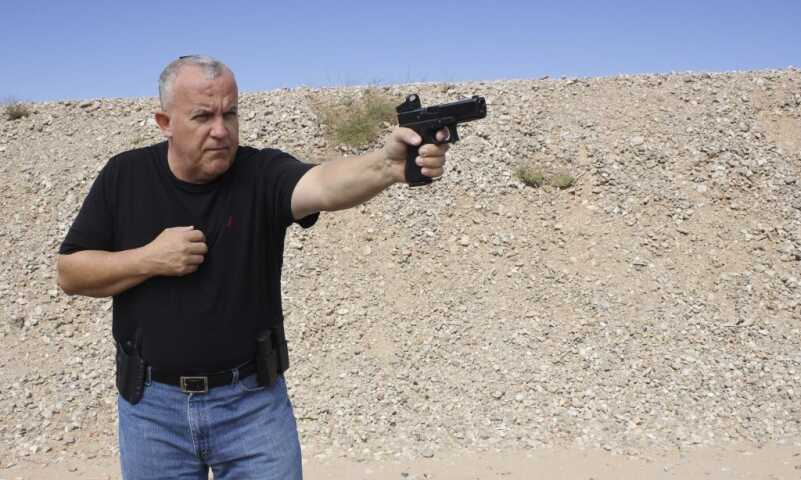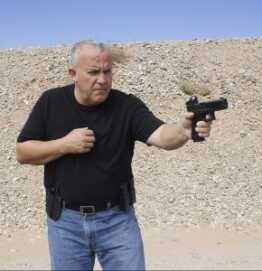In the world of defensive handguns, those serious about the art are always practicing for worst case scenarios. While we would hope that we would have sufficient time to secure a good grip etc., hope is not a course of action. We must focus on the “what if” situations. One that does not get as much attention as it should is single handed, support side shooting.

One handed shooting is an important skill to master. It takes practice and patience to become effective and accurate.
Generally referred to as “weak side” shooting this skill set focuses on the ability to fire and manipulate your weapon when your dominant hand or arm is injured. This is a critical skill to master and a failure to do so can have lethal consequences. The chances of being shot in your strong side or shooting hand are high. Many people instinctively shoot towards a gun. This is seen over and over again in Simunition training. While there are numerous specific components of support side shooting, we will take a look at some of the most important skills.

The author demonstrates a fluid motion to reach across and acquire his pistol. Reaching with his support hand to index the pisot.
The Draw
Your entire grand plan of action may run into a snag right out of the blocks. An injury to your shooting hand or arm may occur even before you are able to get the gun into the fight. If this is where you are starting then you will need to use your support side hand to get your gun out and into the fight. Where you carry your holster will drive a great deal of this but the principles are the same. Reach with your support side hand and index the pistol. At this point it will be “upside down.” Draw the handgun in a fluid motion. You will need to pivot the gun in your hand. This can be helped by using your leg or another surface as a balance/press point. It is important to keep positive control of the weapon and remain aware of your muzzle orientation. Once the firearm is oriented correctly you can then acquire a firing grip and get to work.

It’s important to draw in a smooth motion. When practicing, work to get the fundamentals and then add speed. It may feel foreign at first as the pistol is upside down when drawing with the support hand.
Putting Rounds on Target
Shooting with the support hand differs very little from shooting one handed with your dominant hand. A well aligned and firm but not crushing grip coupled with a smooth continuous trigger pull will result in accurate and repeatable shots. This will also minimize the movement of the gun in your hand. One specific area to focus on is a smooth press of the trigger directly to the rear. Many times, in one handed shooting the trigger, gets “smeared” as the finger slides across the trigger during the press. This can push shots off. A consistent press also minimizes any snatching of the trigger, which drives shots low.
Reloading the gun
There may be circumstances that force you to reload your gun. As with everything in shooting and manipulations, there is a process to work from. One method to execute a reload is as follows: eject the empty magazine to the ground, reholster the weapon accepting that it only fits in part because it will be “backwards,” index a fresh magazine and seat it into the mag well, reacquire your grip on the gun, draw it back out with a free finger, press down the slide stop and let the action run forward. You are now ready to re-enter the fight if need be.

When drawing with the support hand, shooters will need to pivot the pistol in hand. This skill takes time and practice for it to become second nature.
Malfunction clearances
Unless you train shooting support hand only extensively, malfunctions tend to occur. The most common malfunction is a type two, or failure to eject. The gun moves slightly in your hands and the slide does not get its’ regular motion. The remedy for this malfunction is described as “tap, rack, flip.” This can be done one handed with practice. The first step is to “tap.” This ensures the mag is seated correctly. One method is to use your knee as a surface to tap the mag on. Second is the “rack.” This is where caution and diligence are essential. Sloppy muzzle and trigger discipline can result in serious injury. You will need to find a firm surface to hook your rear sight on. One that is commonly used is the mag pouch or belt. You can also use a countertop or any other firm surface. Hook the sights and drive the gun down thus racking the slide. Make sure it is a full action. The final step of “flip” is incorporated at this point as well. As you rack the slide, flip the gun sharply which will clear anything that may be sitting in the chamber. This technique should be practiced initially under professional supervision. Then training should be done with an empty weapon until you master the skill.
So Much More
This is a very brief look at support side shooting. There is obviously quite a bit more that goes into it if you want to be able to fight this way. There is also positional work, close quarters, weapon retention and numerous other components that must be mastered. If you are serious about the art of gun fighting you would be well served by extensive training on one handed operation. We enjoy shooting with two hands on our dominant side because we are good at it. It is the areas where we are not as effective where we need to train the most! As I opened with, we must be ready for a worst case scenario if we expect to be able to win the day.



If you practice weak hand shooting do you still use the dominant eye (hopefully that makes sense). I’m right hand, right eye dominant. I know exactly where to shoot with both eyes open because I know what my dominant eye is seeing. But if you switch to weak hand doesn’t that change which eye you rely on?
Could be another argument for appendix carry. You could access it much easier with the other hand if needed, without all the manipulation. Also, most people that carry concealed are more likely to carry about 4 o’clock, which would make this impossible for 99% of the people. But if OWB carry at 3 o’clock, seems a good thing to practice.
In the old cavalry days, the US Army generally had officers carry their sidearm right side, left hand cross-draw. Two reasons mostly: (1) your sabre would be on the left for cross-draw by the right hand; and (2) cross-draw to the left in case you can’t reach for it with your right hand. Right hand can still draw from the holster with a flick of the wrist.
The dynamic is highly functional. For years the FBI used it. Its called the cavalry draw. Other gunfighters used two pistols. One a cross-draw slant holster close to the front (to avoid being grabbed from behind and shot with your own gun), and a second shoulder holster, left hand cross-draw usually hidden under a vest or dust, flap or frock coat.
Cavalry draw is a better way to carry if you get used to it, in case your right hand is incapacitated or occupied otherwise.
I have to comment on what I feel is an excess of hand movement, which might lead to fumbling. As a woman I avoid carrying in a purse, another excess movement issue, but rather a cross draw from left to right, I’m left handed, also, no pun, large breasted, which is another issue to address. I do believe in a lot of one handed practice. I also believe one should do a lot of dry fire practice from various positions and with types of carry set ups. The too, that might be expensive. ” Being safe, like growing old, ain’t fer sissies.”
Guess no comments here
All I can say is i have been carrying a revolver with my CCW for 46 years for my own defense. Seems like good practice for a police or SWAT officer.
Or you could get a pistol made for a one handed person like my Norinco 9mm M77B where you can charge the pistol with the trigger guard and your finger. An interesting pistol. Not related to articular but made me think of my gun in the collection.
All in all odds of me having to do what this articular advises for my own self defense is pretty slim. (I’ve a concealed carry licence for 46 years.)